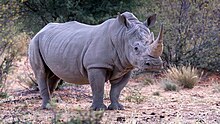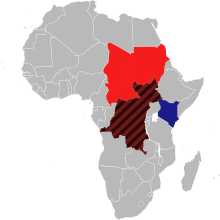| White rhinoceros[1] Temporal range: Early Pleistocene - Recent
| |
|---|---|

| |
| A white rhinoceros in South Africa | |
| Scientific classification | |
| Domain: | Eukaryota |
| Kingdom: | Animalia |
| Phylum: | Chordata |
| Class: | Mammalia |
| Order: | Perissodactyla |
| Family: | Rhinocerotidae |
| Genus: | Ceratotherium |
| Species: | C. simum
|
| Binomial name | |
| Ceratotherium simum (Burchell, 1817)
| |
| Subspecies | |
|
Ceratotherium simum cottoni (northern) | |

| |
| White rhinoceros original range.
Northern (C. s. cottoni)
Southern (C. s. simum))
| |

| |
| Northern white rhino distribution according to the IUCN (as of 2020).
Extant and assisted colonisation (resident)
Extinct
Possibly extinct
| |

| |
| Southern white rhino distribution according to the IUCN (as of 2020).
Extant (resident)
Extant and reintroduced (resident)
Extant and assisted colonisation (resident)
Presence uncertain & assisted colonisation
| |
| Synonyms | |
| |
The white rhinoceros, white rhino or square-lipped rhinoceros (Ceratotherium simum) is the largest extant species of rhinoceros. It has a wide mouth used for grazing and is the most social of all rhino species. The white rhinoceros consists of two subspecies: the southern white rhinoceros, with an estimated 16,803 wild-living animals,[3] and the much rarer northern white rhinoceros. The northern subspecies has very few remaining individuals, with only two confirmed left in 2018 (two females: Fatu, 24 and Najin, 29, both in captivity at Ol Pejeta). Sudan, the world's last known male northern white rhinoceros, died in Kenya on 19 March 2018 at age 45.[4]
- ^ Grubb, P. (2005). "Order Perissodactyla". In Wilson, D.E.; Reeder, D.M (eds.). Mammal Species of the World: A Taxonomic and Geographic Reference (3rd ed.). Johns Hopkins University Press. pp. 634–635. ISBN 978-0-8018-8221-0. OCLC 62265494.
- ^ a b Emslie, R. (2020). "Ceratotherium simum". IUCN Red List of Threatened Species. 2020: e.T4185A45813880. doi:10.2305/IUCN.UK.2020-1.RLTS.T4185A45813880.en.
- ^ "Rhino population figures". SaveTheRhino.org. 2015. Retrieved 18 March 2023.
- ^ "World's last male northern white rhino dies". CNN. 20 March 2018. Retrieved 20 March 2018.
Cite error: There are <ref group=note> tags on this page, but the references will not show without a {{reflist|group=note}} template (see the help page).
